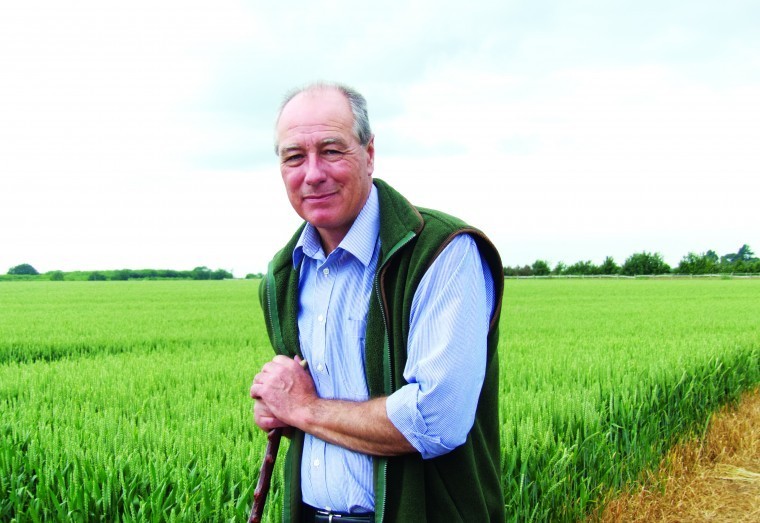Looking back I realise that I did not write much about farming last month and that really was because the dry, cold weather meant not a lot happened crop-growth wise and to an extent disease wise.
Until 48 hours ago I thought his article would be more of the same – lamenting the lack of moisture with just the odd showers from the north east helping crops limp along for another few days before looking stressed again. April showers were noticeable more for their absence than anything else. What is also interesting is that I thought that it was only the South East and Kent in particular that was dry but having spoken to farmers from Devon to Yorkshire, the dry conditions have extended across most of the country. Measuring rainfall in an old fashioned gauge was difficult as there was so little to measure so we have bought a new electronic weather station that links into iPad and smartphones to keep up with all aspects of the weather. Co linking to other stations in Kent gives the ability to weather watch remotely the more outlying farms. Technology!
Now after 48 hours and 48 millimetres of rain – more than twice what we had seen in the previous eight weeks – crops are transformed. Nitrogen that had been sitting on the surface or in the soil with insufficient moisture for uptake has suddenly become available and turned crops visibly dark green.
Winter oilseed rape was the only crop that enjoyed the dry weather as it flowered for a long time setting a lot of pods with only one significant frost event. Main racemes are very well podded and there is depth to the pod canopy that we have not seen for several years.
Where there were late areas from pigeon damage, flowering continues and crops look full of potential. Earlier in the year with oilseed prices comfortably above £300 a tonne, I did think economically we should be using Nufol for the first time in several years. The very dry weather convinced me not to bother as potential pod damage in drought stressed crops can depress yield. Now we have seen the late rain, in terms of oilseed development I think the late surge in available nitrogen should do everything that a Nufol application might have added so we will stick with saving the money this year.
Wheat certainly has been stressed to varying degrees for weeks and clearly tiller numbers have been reduced. Any varieties that are extra sensitive to dry weather and poor soils have certainly not been a sight to enjoy. Whether that is a reason to drop those varieties really depends on what we find when we have combined them and have comparative figures. I have long thought with the range of good varieties available I would much rather grow a robust disease resistant variety – not least because they look well in the field which normally transfers well into yields.
With the exception of crops suffering from early yellow rust infection the dry weather has helped with low disease pressure and has naturally regulated growth in all but the very strongest and thickest of crops. So we have saved on some growth regulators and to a degree on fungicides but as we approach T2 with the rain delivering significant quantities of water we will be back to robust treatments including SDHI fungicides. The weather has been exceptional but as we know from 2012, sunshine as well as rain is essential to make crops yield, and, while the wheat may look thinner than I would choose, with adequate sunshine the turn in the weather may well be in time to produce good yields.
Spring crops have had one notable feature so far and that is the poor residual weed control for broadleaved and grassweeds. This is particularly noticeable in spring beans where we have had to deal with post emergence after spending significant sums pre emergence. There are good seed beds but the lack of moisture to make the chemicals work has been disappointing. This is the exact reverse of the autumn experience when there was just enough rain to make the autumn residuals work well. Once again they have been transformed in a couple of days with spring beans growing rapidly just as they come into flower. A good sign.
Spring barley- which we are only growing for its ability to compete with spring germinating black grass – thus far has had trouble growing at all and it will be interesting to see if it does compete. At least the black grass has been slow as well where it has come through the residual herbicides. Again not just the lack of moisture but also the non availability of nitrogen has hindered growth. Still just in time with a bit of luck.
Winter beans are flowering and looked well before the rain so again this was well timed and they are looking even better now. With very low background disease levels and one fungicide already applied it should be possible to keep them clean through to senescence. As a crop round up that really is encouraging and far more than I dared hope a few days ago.
Politically in the UK we have seen a Conservative manifesto that commits to agricultural support at least until 2022 in some form which is encouraging as it will give them time to sort out what they want to do policy wise, assuming they get reelected with a majority. The alternative manifestoes are something to behold and whether they are serious attempts or just formed in the knowledge they will never be implemented I do not know. But I do recall David Cameron including a policy for a European Union exit referendum on that assumption and look where it got him – in an updated shepherd’s hut looking for inspiration as an author.




